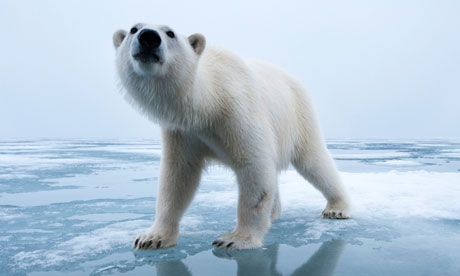Tracking polar bears across the Arctic ice
Though a constant presence as they hunt on the ice floes in northern Greenland, it's rare that a bear attacks

At this time of year polar bears hunt across the ice floe. Photograph: Paul Souders/Corbis
The greatest danger up here on the Arctic ice is not getting lost or separated, falling in the water or freezing, but polar bears. At this time of year they hunt across the ice floes and are likely to come close out of curiosity. Already we have seen several on floes.
Travelling with us – with a rifle – is Roland Hansen, a recently disbanded Danish soldier who has finished 26 months patrolling Denmark's remote 3,000km coastline in northern Greenland with the unique Sirius dog sledge teams.
Taking tents, rifles, maps, satellite phones and enough food for days, six teams of two men, each with 13 dogs, travel continuously 5,000-6,000km a year between drop-off points where they have prepositioned supplies.
"Bears travel big distances, they can swim hundreds of miles, from Greenland as far as Iceland. They are a constant presence in northern Greenland. We know mostly where they are. In November and December it's dark so we seldom see them. The sun rises in February and then they are there.
"They like to go round us about 500-1,000m away. They are curious about what we are doing. They hear the dogs and smell us. They can come too close so we scare them off with flare guns. We do everything we can to avoid confrontations. They can move 50-60kph, whereas we can only do 10kph on our sledges."
When a bear attacks – which is rarely says Hansen – it will often be a young one, two or three years old whose mother has left it and who cannot find food to eat. "He may be ill, not know his limits. We only shoot them at a 15-metre distance," he says.
"Each team perhaps has to shoot one only every four or five years, whereas some Inuit communities have licences to kill 30 a year for food. I have never eaten bear.
"We are quite likely to see them. I will patrol the floe. I would expect to see them. They hunt on the edges of the floes."
What he does not have with him are his dogs. These Greenlandic huskies, he says, are remarkable for their strength, stamina and loyalty. One of his, called Armstrong, is 12 years old and has pulled sledges over 100,000km.
"They are really well looked after. We depend on them for everything. They are our way of living. Without them we could never do the 3,000km journeys we do. They enable you to go places that snowmobiles would never let you. Each team has a top dog, which is like your right arm. You are very connected to all them."
The relationship with the other man in the team is equally important.
"There's just the two of you, out there in the wilderness. My buddy is my doctor, my dentist, everything. He must be able to operate on me and I on him. We need to connect."
Fuente: The Guardian.
No hay comentarios:
Publicar un comentario